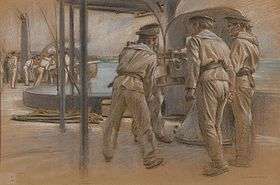Adolf Hirémy-Hirschl

Adolf Hirémy-Hirschl (1860–1933) was a Hungarian, Jewsish artist[1] known for historical and mythological painting, particularly of subjects pertaining to ancient Rome. Some of his major history paintings have been lost, and many of his smaller works were retained by his heirs until the early 1980s. Although he was one of the most successful artists of fin-de-siècle Vienna, these circumstances, along with the rise of Gustav Klimt and the Vienna Secessionists, put his reputation in eclipse.[2]
Education and career
Hirémy-Hirschl was born 31 January 1860 in Timișoara,[3] then a part of Hungary, but at an early age he went to Vienna to study. He received a scholarship to attend the Akademie der bildenden Künste in 1878. He won his first prize two years later with Farewell: Scene from Hannibal Crossing the Alps, followed in 1882 by a prize that allowed him to travel to Rome.
His time in Rome was a major influence on his choice of subject matter. After returning to Vienna, he produced the acclaimed large-scale canvas The Plague in Rome (1884), a work that is now lost. He enjoyed a successful career with numerous commissions and high praise for his historical and allegorical works, culminating in the Imperial Prize in 1891. During the rise of Klimt and the Vienna Secession movement, he began using the name Adolf Hirémy and moved to Rome, where he spent the last 35 years of his life as an eminent member of the expatriate art community. In 1904, seventy of his works were exhibited at a retrospective. He was admitted to the Accademia di San Luca in 1911.
One of his last works was Sic Transit … (1912), an immense allegorical polyptych on the fall of the Roman Empire and the rise of Christianity. His heirs retained possession of his studio for decades following his death. A large number of his drawings, watercolors, pastels, and oil sketches became public only in the early 1980s.
He died in Rome in 1933.
As an artist

Hirémy-Hirschl is regarded as an accomplished draughtsman. His numerous figure and drapery studies in charcoal or chalk were mostly intended to be preparatory studies for paintings. His studies for Souls on the Banks of the Acheron and Sic Transit … were often executed on blue, lavender, or orange paper that enhanced the play of light in relation to the forms he drew. His female nudes are known for their "directness and overt sexuality". He also produced landscape studies in pastel, watercolor and gouache. Fragmentation is characteristic of his drawings, "the sustained attempt to perfect the single part" which at the same time represented a "means of escape from completion and synthesis".
Some of his paintings are considered Symbolist.[4] Ahasuerus at the End of the World (1888) is executed in a restricted palette of blue, gray, black, white, with touches of gold and lingering warmth in the flesh of the foregrounded female nude. The title figure "is the last man in the polar wilderness, caught between the angel of hope and the specter of death. Before him lies a fallen female figure, the personification of dead humanity, as crows circle ominously. … The primary light appears to radiate from the distant angel, who hovers before a stormy sky."[5]
Works
| Wikimedia Commons has media related to Adolf Hirémy-Hirschl. |
Paintings by Hirémy-Hirschl include:
- Farewell: Scene from Hannibal Crossing the Alps (1880)
- The Plague of Rome (1884, lost)
- Saint Cecilia
- Prometheus
- The Vandals Entering Rome
- Ahasuerus at the End of the World (1888)
- Souls on the Banks of the Acheron (1898)
- The Tomb of Achilles[6]
- Sic Transit … (1912)
References
- ↑ A Checklist of Painters, c1200-1994 Represented in the Witt Library, Courtauld Institute of Art, London (Courtauld Institute of Art, 1995, 2nd ed.), p 229.
- ↑ Unless otherwise noted, information in this article comes from "Adolf Hiremy-Hirschl," biography at artnet.com.
- ↑ La Chronique des arts et de la curiosité (19 January 1901), p. 20.
- ↑ James Gurney, Color and Light: A Guide for the Realist Painter pp. 22–23.
- ↑ Gurney, Color and Light, p. 22.
- ↑ Ask Art, Adolf Hiremy-Hirschl
External links
- Study of a Standing Female Nude, brown chalk highlighted with white chalk on light brown paper, artnet